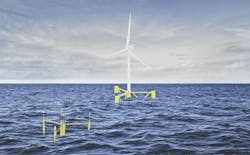TotalEnergies Piloting Floating Offshore Wind Turbine to Electrify Gas Production Platform in North Sea
French-based multinational energy and petroleum producer TotalEnergies is going to try a floating wind turbine to see if it can supply adequate and decarbonizing power to an offshore natural gas platform in the North Sea.
The 3-MW floating wind turbine is part of a pilot project by TotalEnergies and should be operational by the end of this year, the company reported. It will be connected to the Culzean offshore platform in the United Kingdom region of the North Sea.
Once operational, the aim is to power 20% of the Culzean platform’s power requirement with renewable, carbon-free energy and thus reducing carbon emissions.
“This innovative pilot project aims at proving the concept of hybridization of power generation of an offshore facility by integrating the generation of renewable electricity from a floating wind turbine with the existing power generation from gas turbines,” Marie-Noelle Semeria, chief technology officer at TotalEnergies, said in a statement. “It also aims at qualifying a promising floater design for the future of floating offshore wind.”
The wind turbine will be installed on a modular, light semi-submersible floater hull designed by Ocergy. The pilot project was selected in Crown Estate Scotland’s Innovation and Targeted Oil and Gas leading round of funding decisions..
Culzean is a gas condensate field located in the North Sea some 230 kilometers off the coast of Aberdeen, Scotland. TotalEnergies’ production platform was commissioned five years ago and produces close to 105,000 barrels of oil equivalent per day, according to the company.
Despite a global push toward net zero emissions in the energy sector as early as 2050, most forecasts acknowledge that oil and gas will continue to make up a significant share of the energy mix at that point. Natural gas currently accounts for nearly 40% of the resources generating the U.S. electricity mix, according to the federal Energy Information Administration.
IHS Markit noted several years ago that the number of traditional oil and gas companies using field-based renewables has expanded beyond isolated projects. Global-scale players such as ExxonMobil, BP and Shell are exploring renewable or lower carbon energy investments, including hydrogen production as well as solar and wind.
Others such as NRG, Valero and Occidental are exploring decarbonization through carbon capture projects.
TotalEnergies is one of the seven biggest global oil and gas companies. Its revenues topped US$250 billion in 2022, according to reports.
About the Author
Rod Walton, EnergyTech Managing Editor
Managing Editor
For EnergyTech editorial inquiries, please contact Managing Editor Rod Walton at [email protected].
Rod Walton has spent 17 years covering the energy industry as a newspaper and trade journalist. He formerly was energy writer and business editor at the Tulsa World. Later, he spent six years covering the electricity power sector for Pennwell and Clarion Events. He joined Endeavor and EnergyTech in November 2021.
Walton earned his Bachelors degree in journalism from the University of Oklahoma. His career stops include the Moore American, Bartlesville Examiner-Enterprise, Wagoner Tribune and Tulsa World.
EnergyTech is focused on the mission critical and large-scale energy users and their sustainability and resiliency goals. These include the commercial and industrial sectors, as well as the military, universities, data centers and microgrids. The C&I sectors together account for close to 30 percent of greenhouse gas emissions in the U.S.
He was named Managing Editor for Microgrid Knowledge and EnergyTech starting July 1, 2023
Many large-scale energy users such as Fortune 500 companies, and mission-critical users such as military bases, universities, healthcare facilities, public safety and data centers, shifting their energy priorities to reach net-zero carbon goals within the coming decades. These include plans for renewable energy power purchase agreements, but also on-site resiliency projects such as microgrids, combined heat and power, rooftop solar, energy storage, digitalization and building efficiency upgrades.


